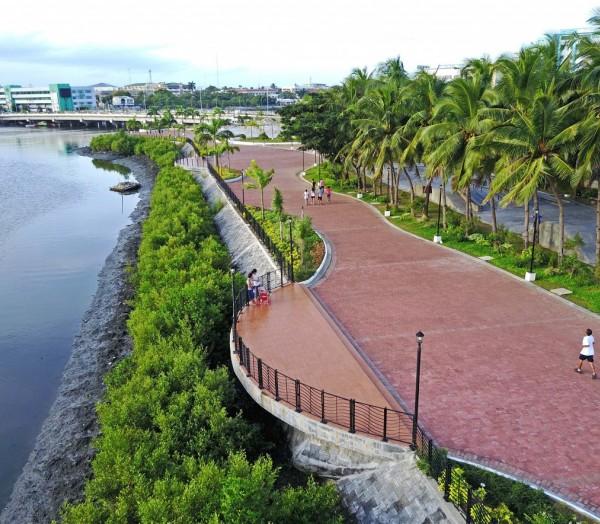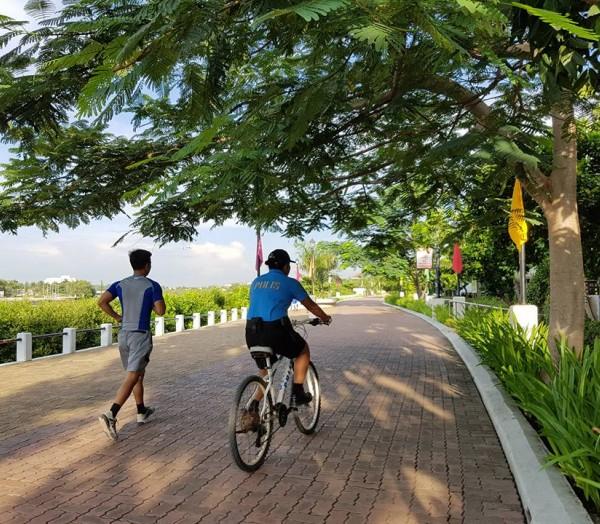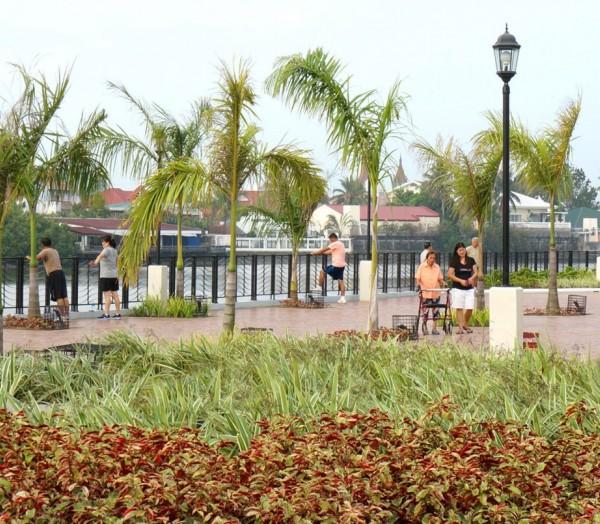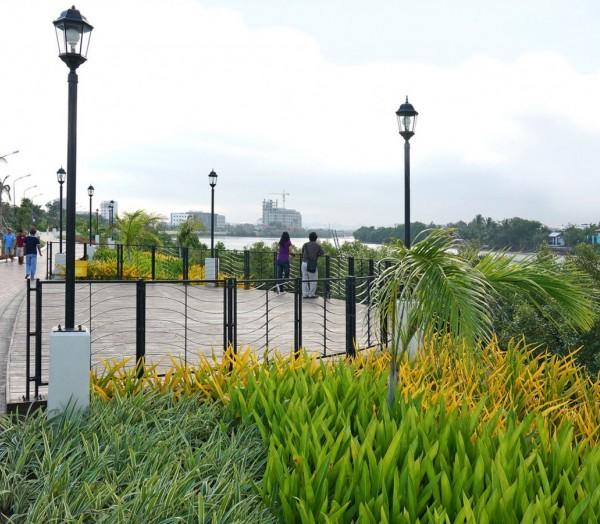Iloilo River Esplanade is a promenade and linear park along the Iloilo River, created as part of the Iloilo River Rehabilitation Project. It is the largest linear park in the Philippines and was designed by the landscape architect Paulo Alcazaren. The esplanade is one of a kind in the country that aims to foster biodiversity, store carbon by mangroves and provide protection from possible flood damages. Furthermore, the project aspires to build a lifestyle hub for the locals and promotes educational eco-tourism. The site was an existing dike road devoid of shade and originally built just as a flood control measure. The redesign has showcased its effect on public amenities, received several recognitions and has become a magnet for tourists in this city. [1, 3, 6, 7]
Overview
Nature-based solution
- Blue infrastructure
- Rivers/streams/canals/estuaries
- Coastal wetland, mangroves and salt marshes
- Grey infrastructure featuring greens
- Riverbank/Lakeside greens
Key challenges
- Climate action for adaptation, resilience and mitigation (SDG 13)
- Climate change adaptation
- Climate change mitigation
- Green space, habitats and biodiversity (SDG 15)
- Habitat and biodiversity restoration
- Habitat and biodiversity conservation
- Green space creation and/or management
- Regeneration, land-use and urban development
- Promote natural styles of landscape design for urban development
- Water management (SDG 6)
- Flood protection
- Economic development and employment (SDG 8)
- Tourism support
- Real estate development
Focus
Project objectives
Implementation activities
Climate-focused activities
Climate change adaptation:
- Implement sustainable urban drainage infrastructure (e.g. to make space for water)
- Renaturalization of rivers and other water bodies
Climate change mitigation:
- Increase green urban nature for carbon storage (wetlands, tree cover)
Biodiversity conservation or restoration-focused activities
Biodiversity conservation:
- Protect and enhance urban habitats
- Preserve and strengthen existing habitats and ecosystems
- Promote environmentally-sound development in and around protected areas
- Create new habitats
- Protect species
- Undertake specific measures to protect species
- Undertake specific measures to protect native species
- Undertake specific measures to protect valued species
- Means for conservation governance
- Public engagement
Biodiversity restoration:
- Rehabilitate and restore damaged or destroyed ecosystems
- Restore species (native, endangered, or unspecified)
- Restore native species
Main beneficiaries
- Local government/Municipality
- Citizens or community groups
Governance
Management set-up
- Government-led
Type of initiating organisation
- Local government/municipality
Participatory approaches/ community involvement
- Unknown
Details on the roles of the organisations involved in the project
Project implemented in response to ...
Financing
Total cost
Source(s) of funding
- Public local authority budget
Type of funding
- Direct funding (grants, subsidies, or self-financed projects by private entities)
Non-financial contribution
Impacts and Monitoring
Environmental impacts
- Climate change
- Strengthened capacity to address climate hazards/natural disasters
- Enhanced carbon sequestration
- Water management and blue areas
- Increased protection against flooding
- Enhanced protection and restoration of freshwater ecosystems
- Green space and habitat
- Increased green space area
- Increased conservation or restoration of ecosystems
- Reduced biodiversity loss
- Increased number of species present
Economic impacts
- Increase of green jobs (e.g. paid employment positions)
- More sustainable tourism
- Increased property prices
- Attraction of business and investment
Socio-cultural impacts
- Social justice and cohesion
- Improved access to urban green space
- Increased opportunities for social interaction
- Health and wellbeing
- Gain in activities for recreation and exercise
- Cultural heritage and sense of place
- Improvement in people’s connection to nature
- Education
- Increased support for education and scientific research
- Increased awareness of NBS and their benefits
- Safety
- Improved community safety to climate-related hazards
- Decreased crime rates
Type of reported impacts
Presence of formal monitoring system
Presence of indicators used in reporting
Presence of monitoring/ evaluation reports
Availability of a web-based monitoring tool
References
2. Center for West Visayan Studies. (n.d.) Iloilo River Esplanade. Unoversity of THE Philippines Visayas. Google Art and Cutlture. URL: Source link. Accessed on 14th May, 2022.
3. Treñas, J. (2021) ILOILO RIVER ESPLANADE: FROM A LIFESTYLE HUB TO ALSO AN EDUCATIONAL ECO-TOURISM HUB. Facebook Post. URL: Source link. Accessed on 14th May, 2022.
4. JCI Regatta - Iloilo. (2022). HARBOURING FORWARD: MANGROVE GROWING. Facebook Post. URL: Source link. Accessed on 14th May, 2022.
5. Albay, R. (2022). How Iloilo City brought its river back to life and back to its people. ABS-CBN. URL: Source link. Accessed on 14th May, 2022.
6. Tayona, G. (2021). Iloilo River Esplanade eyed as educational ecotourism hub. Panay News. URL: Source link. Accessed on 14th May, 2022.
7. Momblan, G. (2019). New sections of Iloilo Esplanade launched. Philippine News Agency. Republic of the Philippines. URL: Source link. Accessed on 14th May, 2022.
8. PGAA Creative Design (n.d.) Iloilo Esplanade. URL: Source link. Accessed on 14th May, 2022.
9. Taclino, N. (2020). More mangroves at new Esplanades. Iloilo Today, URL: Source link. Accessed on 14th May, 2022.
10. Burgos, N. P. Jr. (2012). With Esplanade Comes a New Iloilo River Experience. Source link. URL: Source link. Accessed on 14th May, 2022.
11. Yap, T. (2022). Source link Iloilo road expansion, river park projects underway. Manila Bulletin. URL: Source link. Accessed on 14th May, 2022.




